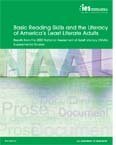Health Literacy Literature Reviews
Health Literacy Population Assessments
Adult Literacy Population Assessments
Health Literacy Literature Reviews
- Health Literacy Interventions and Outcomes: An Updated Systematic Review by N. Berkman et al. Rockville (MD): Agency for Healthcare Research and Quality (US). Report No.: 11-E006; (2011).
- Health Literacy: An Updated Review of the Medical and Public Health Literature. by R. Rudd with J. Epstein Anderson, S. Oppenheimer, C. Nath. Annual Review of Adult Learning and Literacy, Volume 7; (2007).
- “Understanding Health Literacy and its Barriers” by M. Zorn, M. Allen, A. Horowitz. Library of Medicine; (2004).
- Health Literacy: A Review of the Medical and Public Health Literature. by R. Rudd, B. Moeykens, T. Colton. Annual Review of Adult Learning and Literacy, Volume 1; (2000).
Health Literacy Population Assessments
The first analysis of population-based health literacy skills among adults was undertaken by Rudd, Kirsch, and Yamamoto (2004). Rudd developed a typology of health activities and coded all health-related items and tasks on adult literacy surveys. Referred to as the Health and Adult Literacy Survey (HALS), the coding and the latent class analyses model supported an approach to assessing skills of adults within and across countries. Analyses were subsequently undertaken in Canada and Australia and are underway elsewhere.
Separately, the U.S. Department of Health and Human Services worked with the Department of Education to insert a number of specific health-related items in the follow-up to the 1992 NALS. The National Assessment of Adult Literacy (NAAL), fielded in 2003, included a purposive sample of materials and items (n=28) related to health. The report, issued in 2006, focused on responses to the 28 items.
Overall, all reports indicate that health literacy is not independent of social factors and that population groups generally considered to be at risk for health issues (including the elderly, the poor, those without a high school degree, those who have limited resources, those who live in less resourced areas, and those who are members of minority populations) are also more likely to have limited health literacy proficiencies.
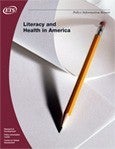 Literacy and Health in America by R. Rudd, I. Kirsch, and K. Yamamoto. Educational Testing Service; 2004.
Literacy and Health in America by R. Rudd, I. Kirsch, and K. Yamamoto. Educational Testing Service; 2004.
The HALS analysis of 191 coded health items offers evidence that average proficiencies in the U.S. are limited — on average, adults have difficulty performing health related tasks using health materials drawn from a broad spectrum of activities. Materials and tasks relate to health promotion, health protection, disease prevention, health maintenance and care, and health systems navigation. Analyses indicate links between limited health literacy and compromised health status, limited engagement in civic activities, and reduced access to health information.
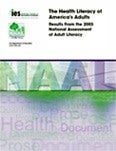 The Health Literacy of America’s Adults: Results from the 2003 National Assessment of Adult Literacy by M. Kutner, E Greenburg, Y. Jin et al. US Department of Education; 2006.
The Health Literacy of America’s Adults: Results from the 2003 National Assessment of Adult Literacy by M. Kutner, E Greenburg, Y. Jin et al. US Department of Education; 2006.
This analysis was based on the 28 items purposively inserted into the 2003 National Assessment of Adult Literacy. Findings indicate that the average scores reported for the NAAL health literacy measure are lower than are those for general literacy among adults. The conclusion reached is that large numbers of U.S. adults do not have health literacy skills that would enable them to effectively use health materials to accomplish challenging or complex health-related literacy tasks.
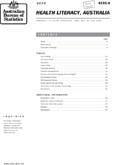 Health Literacy, Australia. Australian Bureau of Statistics. Publication 4233.0. Canberra: Australian Bureau of Statistics;(2006).
Health Literacy, Australia. Australian Bureau of Statistics. Publication 4233.0. Canberra: Australian Bureau of Statistics;(2006).
The health literacy assessment is based on the HALS analytic process applied to the Adult Literacy and Life skills Survey (with over 200 health related items). Here too, findings provide a portrait of health literacy in Australia and indicate that overall, about half of Australian adults have difficulty using health materials with accuracy and consistency.
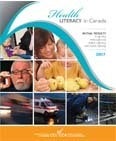 Health Literacy in Canada by S. Murray, R. Rudd, I. Kirsch, K. Yamamoto, and S. Grenier. Ottawa: Canadian Council on Learning; (2007).
Health Literacy in Canada by S. Murray, R. Rudd, I. Kirsch, K. Yamamoto, and S. Grenier. Ottawa: Canadian Council on Learning; (2007).
The authors report on the distribution of health literacy among Canadians and analyze public policy implications with the HALS analytic process. Over 200 items from the Adult Literacy and Lifeskills Survey were identified as health related. Health literacy scores were based on an analysis of these items. Findings indicate that health literacy scores vary by province and territory but that more than half of Canadian adults have difficulty using commonly available health materials to accomplish health-related tasks.
Adult Literacy Population Assessments
Background and Methodology
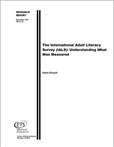 The International Adult Literacy Survey (IALS): Understanding What Was Measured by I. Kirsch. Educational Testing Services, Center for Global Assessment; December, (2001). This paper provides a thorough explanation of the framework used to develop the tasks on the IALS. The framework is comprised of six parts: Defining Literacy, Organizing the Domain, Task Characteristics, Identifying and Operationalizing Variables, validating Variables and Building an Interpretive Scheme. The author provides a clear explanation of regression analyses that identify and verify variables associated with performance on the literacy tasks in the IALS.
The International Adult Literacy Survey (IALS): Understanding What Was Measured by I. Kirsch. Educational Testing Services, Center for Global Assessment; December, (2001). This paper provides a thorough explanation of the framework used to develop the tasks on the IALS. The framework is comprised of six parts: Defining Literacy, Organizing the Domain, Task Characteristics, Identifying and Operationalizing Variables, validating Variables and Building an Interpretive Scheme. The author provides a clear explanation of regression analyses that identify and verify variables associated with performance on the literacy tasks in the IALS.
National Assessment of Adult Literacy (NAAL) Findings
The 2003 National Assessment of Adult Literacy by the National Center for Education Statistics. US Department of Education; 2005. NAAL is a nationally representative assessment of English literacy among American adults age 16 and older. Sponsored by the National Center for Education Statistics (NCES), NAAL is the nation’s most comprehensive measure of adult literacy since the 1992 National Adult Literacy Survey (cited below).
Adult Literacy and Life Skills Survey (ALLS) Findings
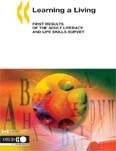 Learning a Living: First Results of the Adult Literacy and Life Skills Survey. Statistics Canada. Ottawa and Paris: Organisation for Economic Co-operation and Development Publishing; (2005).
Learning a Living: First Results of the Adult Literacy and Life Skills Survey. Statistics Canada. Ottawa and Paris: Organisation for Economic Co-operation and Development Publishing; (2005).
This report focuses on a new iteration of the adult literacy surveys, adding attention to problem solving skills and numeracy [addressing math concepts beyond simple computation skills]. This report presents findings on literacy skills from seven countries. In each country, between one-third and two-thirds of adult populations do not attain the skill levels considered to be the minimum for coping with increasing societal demands for literacy.
International Adult Literacy Survey (IALS) Findings
 The Twin Challenges of Mediocrity and Inequality: Literacy in the U.S. from an International Perspective, by A. Sum, I. Kirsch and R. Taggart. Educational Testing Services, Statistics and Research Division; Center for Global Assessment; February, (2002). This report compares U.S. results on the International Adult Literacy Survey with those of 20 other nations. While U.S. adults performed in the average range for participating high-income countries, comparative findings indicate greater disparities in the U.S. than in other countries, indicating a possible unequal divide in the distribution of economic and civic benefits
The Twin Challenges of Mediocrity and Inequality: Literacy in the U.S. from an International Perspective, by A. Sum, I. Kirsch and R. Taggart. Educational Testing Services, Statistics and Research Division; Center for Global Assessment; February, (2002). This report compares U.S. results on the International Adult Literacy Survey with those of 20 other nations. While U.S. adults performed in the average range for participating high-income countries, comparative findings indicate greater disparities in the U.S. than in other countries, indicating a possible unequal divide in the distribution of economic and civic benefits
National Adult Literacy Survey (NALS) Findings
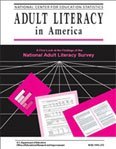
Adult Literacy in America: The First Look at the Results of the National Adult Literacy Survey (NALS), by I. Kirsch, A. Jungeblut, L. Jenkins and A. Kolstad. Washington, DC: U.S. Department of Education; (1993).
This report focused on data from the 1992 National Adult Literacy Survey on the English literacy skill levels of U.S. adults. Findings are based on an in-home assessment of people’s use of everyday materials. Findings indicate that about half of U.S. adults have difficulty using print materials with accuracy and consistency.
 Literacy Behind Prison Walls, Haigler, Karl O., Caroline Harlow, Patricia O’Connor, et al., U.S. Department of Ed., NCES, Washington, DC, (1994). The NALS evaluated a sample of inmates in federal and state prisons. Results showed that the demographic characteristics of this population were different than those for the entire population. Inmates tended to be younger and less educated than the average adult. According to NALS, only 20 percent of inmates reported that they completed some post-secondary education. 94 percent of inmates were male, as opposed to 48 percent of the general adult population. Individuals in prisons were also different racially/ethnically than the general population, with Black, Hispanic and American Indian/Alaskan Natives being over-represented in the prison population. Incarcerated individuals were much more likely than adults in the total population to score in lower levels on all three literacy scales. The percentage of the prison population scoring in Level 1 on each scale ranged from 31 to 40 percent, compared to 21 to 23 percent in the average adult population. The percentage of the prison population scoring in Levels 4 and 5 varied from 4 to 7 percent, compared to 18 to 21 percent in the total population.
Literacy Behind Prison Walls, Haigler, Karl O., Caroline Harlow, Patricia O’Connor, et al., U.S. Department of Ed., NCES, Washington, DC, (1994). The NALS evaluated a sample of inmates in federal and state prisons. Results showed that the demographic characteristics of this population were different than those for the entire population. Inmates tended to be younger and less educated than the average adult. According to NALS, only 20 percent of inmates reported that they completed some post-secondary education. 94 percent of inmates were male, as opposed to 48 percent of the general adult population. Individuals in prisons were also different racially/ethnically than the general population, with Black, Hispanic and American Indian/Alaskan Natives being over-represented in the prison population. Incarcerated individuals were much more likely than adults in the total population to score in lower levels on all three literacy scales. The percentage of the prison population scoring in Level 1 on each scale ranged from 31 to 40 percent, compared to 21 to 23 percent in the average adult population. The percentage of the prison population scoring in Levels 4 and 5 varied from 4 to 7 percent, compared to 18 to 21 percent in the total population.
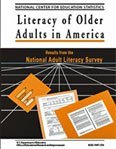 Literacy of Older Adults in America: Results from the National Adult Literacy Survey, by Brown, Pristuta, Jacobs and Campbell. Washington, DC: U.S. Department of Education; (1996).
Literacy of Older Adults in America: Results from the National Adult Literacy Survey, by Brown, Pristuta, Jacobs and Campbell. Washington, DC: U.S. Department of Education; (1996).
More than 1 in 8 Americans are age 65 or older. In order to respond to the literacy needs of older adults in America, the NALS examined the literacy proficiencies of adults age 60 and over. Results of the NALS indicate that low literacy levels are a large problem for many older adults in the U.S. 71 percent of older adults scored in the lowest two levels of prose literacy and 68 percent in the lowest levels of quantitative literacy. Four out of five older Americans demonstrated difficulty in document literacy, scoring in the lowest two Levels. Analysis indicates that skill levels differ by income. The NALS analysis also indicates that many older adults do not believe they have a problem with literacy. While many elders reported receiving help with forms, math and writing letters, the number of adults who receive help is much lower than the number who appear to need assistance.
